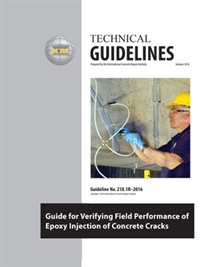
- Publication Date:
- Jan 01, 2016
- License:
- Never Expires.
- Short Description:
- This guideline is intended to assist the contractor, licensed design professional, and owner in the development of performance specifications for quality assurance and quality control of epoxy injection of concrete cracks. It includes process-control methods to assess if satisfactory injection work is being performed. Quality assurance methods described include visual observations and testing samples during the injection work, and removing concrete core samples and performing nondestructive testing of completed repairs.
- Price:
- $31.00 - $62.00
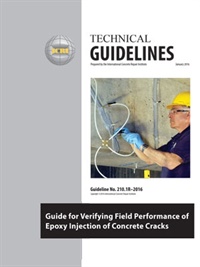
- License:
- Never Expires.
- Short Description:
- This guideline is intended to assist the contractor, licensed design professional, and owner in the development of performance specifications for quality assurance and quality control of epoxy injection of concrete cracks. It includes process-control methods to assess if satisfactory injection work is being performed. Quality assurance methods described include visual observations and testing samples during the injection work, and removing concrete core samples and performing nondestructive testing of completed repairs.
- Price:
- $0.00 - $62.00
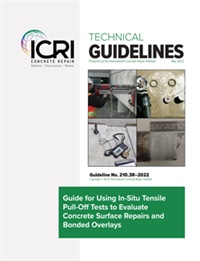
- Publication Date:
- Jan 01, 2022
- License:
- Never Expires.
- Short Description:
- This guide provides a recommended method of evaluating the adequacy of concrete surface preparation and tensile bond strength of cementitious and polymer concrete surface repairs using the in-situ drilled core tensile pulloff test. The guide outlines equipment and material requirements, the test procedure, reporting, and acceptance criteria. This update also includes failure modes for concrete substrate tests.
- Price:
- $31.00 - $62.00
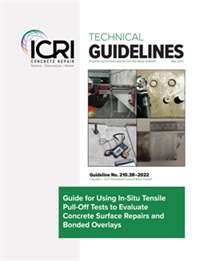
- License:
- Never Expires.
- Short Description:
- This guide provides a recommended method of evaluating the adequacy of concrete surface preparation and tensile bond strength of cementitious and polymer concrete surface repairs using the in-situ drilled core tensile pulloff test. The guide outlines equipment and material requirements, the test procedure, reporting, and acceptance criteria. This update also includes failure modes for concrete substrate tests.
- Price:
- $0.00 - $62.00
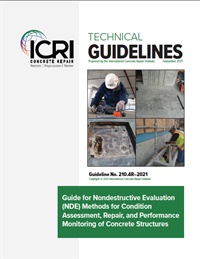
- Publication Date:
- Sep 01, 2021
- License:
- Never Expires.
- Short Description:
- This updated and revised guideline will assist contractors, NDE service providers, owners, design professionals, and material suppliers in the selection of nondestructive evaluation (NDE) methods for evaluating the condition of concrete structures. NDE methods can be very useful to perform a condition assessment prior to repairs and to provide quality control and assurance of repairs and long-term performance monitoring. Considerations in planning and executing an NDE program, including correlating with destructive methods, are discussed in the guideline. Guidance, including a brief synopsis of each method, is presented for selecting which NDE methods are appropriate for the concrete property/condition being assessed.
- Price:
- $31.00 - $62.00

- License:
- Never Expires.
- Short Description:
- This updated and revised guideline will assist contractors, NDE service providers, owners, design professionals, and material suppliers in the selection of nondestructive evaluation (NDE) methods for evaluating the condition of concrete structures. NDE methods can be very useful to perform a condition assessment prior to repairs and to provide quality control and assurance of repairs and long-term performance monitoring. Considerations in planning and executing an NDE program, including correlating with destructive methods, are discussed in the guideline. Guidance, including a brief synopsis of each method, is presented for selecting which NDE methods are appropriate for the concrete property/condition being assessed.
- Price:
- $0.00 - $62.00
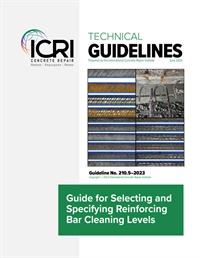
- Publication Date:
- Jun 01, 2023
- License:
- Never Expires.
- Short Description:
- The intent of this document is to provide objective, standards-based comparison for the specification, evaluation, and approval of the degree of surface preparation of exposed conventional reinforcing steel by abrasive media blasting and mechanical hand tool methods. This guide is designed for use with associated illustrative materials available in digital or physical form through ICRI.
- Price:
- $31.00 - $62.00
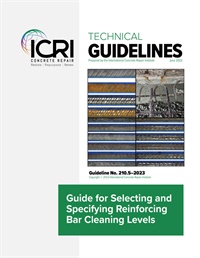
- License:
- Never Expires.
- Short Description:
- The intent of this document is to provide objective, standards-based comparison for the specification, evaluation, and approval of the degree of surface preparation of exposed conventional reinforcing steel by abrasive media blasting and mechanical hand tool methods. This guide is designed for use with associated illustrative materials available in digital or physical form through ICRI.
- Price:
- $0.00 - $62.00

- Presenters:
- Fred Goodwin
- Duration:
- 1 hour
- Format:
- Audio and Video
- License:
- Access for 6 month(s) after purchase.
- Short Description:
- This webinar will cover the basics of concrete, its composition, properties, and deterioration mechanisms.
- Price:
- $0.00 - Base Price

- Presenters:
- Peter Tarara | Chris White
- Duration:
- 1 hour
- Format:
- Audio and Video
- License:
- Access for 6 month(s) after purchase.
- Short Description:
- This presentation will cover technical considerations, repair techniques, concrete repair basics and the selection and use of repair materials.
- Price:
- $0.00 - Base Price

- Presenters:
- Mr. Jorge Costa, P.E.
- Duration:
- 100 minutes
- Format:
- Audio and Video
- License:
- Access for 6 month(s) after purchase.
- Short Description:
- In this presentation, we will address the effect that corrosion has on our concrete infrastructure, including buildings, bridges, sea walls, cooling towers, docks, and many other reinforced concrete structures.
- Price:
- $0.00 - Base Price

- Presenters:
- Mr. Larry D. Olson
- Duration:
- 1 hour
- Format:
- Audio and Video
- License:
- Access for 6 month(s) after purchase.
- Short Description:
- Concrete repair projects are increasingly benefiting from the use of nondestructive evaluation (NDE) methods to diagnose and identify where internal concrete conditions need repair. By overlaying the results from multiple NDE methods, a data fusion approach combines, providing a more accurate surface and full-depth image of concrete bridge conditions for repair designs.
- Price:
- $0.00 - $0.00

- Presenters:
- Dave Fuller | Keith Kesner, P.E., S.E. | David G. Tepke, PE, FACI | John Landry | John McDougall, FICRI, CSRT | Aamer Syed
- Duration:
- 1 hour
- Format:
- Audio and Video
- License:
- Access for 6 month(s) after purchase.
- Short Description:
- This 60-minute session will be comprised of a 10-15 minute introduction to ACI 562, followed by a 45-minute discussion by a moderated panel of various experienced stakeholders in the concrete repair industry, including Specifiers, Contractors, Manufacturer/Distributors, and Owners.
- Price:
- $0.00 - Base Price

- Presenters:
- Mr. Matthew Sherman
- Duration:
- 1 hour
- Format:
- Audio and Video
- License:
- Access for 6 month(s) after purchase.
- Short Description:
- This session will explore the differences between bonded and unbonded topping slabs, discuss materials- and installation-related causes of failures, and provide guidelines to properly implement each type of topping slab.
- Price:
- $0.00 - Base Price

- Presenters:
- Dave Fuller
- Duration:
- 1 hour
- Format:
- Audio and Video
- License:
- Access for 6 month(s) after purchase.
- Short Description:
- This discussion focuses on addressing critical areas to help avoid costly issues when installing protective coatings and sealers.
- Price:
- $0.00 - Base Price

- Presenters:
- Mr. Richard First
- Duration:
- 1 hour
- Format:
- Audio and Video
- License:
- Access for 6 month(s) after purchase.
- Short Description:
- This webinar will review the causes for cracking in concrete and the standard, preventative methods for addressing movement.
- Price:
- $0.00 - Base Price

- Presenters:
- Belin Wills | Ethan Namink
- Duration:
- 1 hour
- Format:
- Audio and Video
- License:
- Access for 6 month(s) after purchase.
- Short Description:
- This unique webinar specifically focuses on the technology, process & application of using high-pressure water to remove concrete, called Hydro Demolition.
- Price:
- $0.00 - Base Price

- Presenters:
- Mr. Eric Muench | Dan Wald
- Duration:
- 1 hour
- Format:
- Audio and Video
- License:
- Access for 6 month(s) after purchase.
- Short Description:
- Industry experts Eric Muench and Dan Wald will discuss how to best select the right traffic bearing waterproof membrane technology for concrete protection.
- Price:
- $0.00 - Base Price

- Presenters:
- John S. Lund
- Duration:
- 1 hour
- Format:
- Audio and Video
- License:
- Access for 6 month(s) after purchase.
- Short Description:
- The new ACI 563-25 repair specifications include information on Crack Repair, Galvanic Anodes, Protective Membranes, Overlays, Precast Concrete Repair, Post-Tensioned Concrete Repair and Architectural Concrete Repair.
- Price:
- $0.00 - $0.00